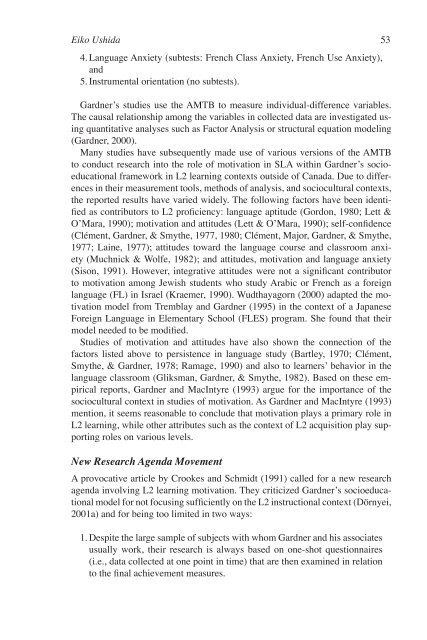The Role of Students' Attitudes and Motivation in Second ... - CALICO
The Role of Students' Attitudes and Motivation in Second ... - CALICO
The Role of Students' Attitudes and Motivation in Second ... - CALICO
Create successful ePaper yourself
Turn your PDF publications into a flip-book with our unique Google optimized e-Paper software.
Eiko Ushida 53<br />
4. Language Anxiety (subtests: French Class Anxiety, French Use Anxiety),<br />
<strong>and</strong><br />
5. Instrumental orientation (no subtests).<br />
Gardner’s studies use the AMTB to measure <strong>in</strong>dividual-difference variables.<br />
<strong>The</strong> causal relationship among the variables <strong>in</strong> collected data are <strong>in</strong>vestigated us<strong>in</strong>g<br />
quantitative analyses such as Factor Analysis or structural equation model<strong>in</strong>g<br />
(Gardner, 2000).<br />
Many studies have subsequently made use <strong>of</strong> various versions <strong>of</strong> the AMTB<br />
to conduct research <strong>in</strong>to the role <strong>of</strong> motivation <strong>in</strong> SLA with<strong>in</strong> Gardner’s socioeducational<br />
framework <strong>in</strong> L2 learn<strong>in</strong>g contexts outside <strong>of</strong> Canada. Due to differences<br />
<strong>in</strong> their measurement tools, methods <strong>of</strong> analysis, <strong>and</strong> sociocultural contexts,<br />
the reported results have varied widely. <strong>The</strong> follow<strong>in</strong>g factors have been identified<br />
as contributors to L2 pr<strong>of</strong>iciency: language aptitude (Gordon, 1980; Lett &<br />
O’Mara, 1990); motivation <strong>and</strong> attitudes (Lett & O’Mara, 1990); self-confidence<br />
(Clément, Gardner, & Smythe, 1977, 1980; Clément, Major, Gardner, & Smythe,<br />
1977; La<strong>in</strong>e, 1977); attitudes toward the language course <strong>and</strong> classroom anxiety<br />
(Muchnick & Wolfe, 1982); <strong>and</strong> attitudes, motivation <strong>and</strong> language anxiety<br />
(Sison, 1991). However, <strong>in</strong>tegrative attitudes were not a significant contributor<br />
to motivation among Jewish students who study Arabic or French as a foreign<br />
language (FL) <strong>in</strong> Israel (Kraemer, 1990). Wudthayagorn (2000) adapted the motivation<br />
model from Tremblay <strong>and</strong> Gardner (1995) <strong>in</strong> the context <strong>of</strong> a Japanese<br />
Foreign Language <strong>in</strong> Elementary School (FLES) program. She found that their<br />
model needed to be modified.<br />
Studies <strong>of</strong> motivation <strong>and</strong> attitudes have also shown the connection <strong>of</strong> the<br />
factors listed above to persistence <strong>in</strong> language study (Bartley, 1970; Clément,<br />
Smythe, & Gardner, 1978; Ramage, 1990) <strong>and</strong> also to learners’ behavior <strong>in</strong> the<br />
language classroom (Gliksman, Gardner, & Smythe, 1982). Based on these empirical<br />
reports, Gardner <strong>and</strong> MacIntyre (1993) argue for the importance <strong>of</strong> the<br />
sociocultural context <strong>in</strong> studies <strong>of</strong> motivation. As Gardner <strong>and</strong> MacIntyre (1993)<br />
mention, it seems reasonable to conclude that motivation plays a primary role <strong>in</strong><br />
L2 learn<strong>in</strong>g, while other attributes such as the context <strong>of</strong> L2 acquisition play support<strong>in</strong>g<br />
roles on various levels.<br />
New Research Agenda Movement<br />
A provocative article by Crookes <strong>and</strong> Schmidt (1991) called for a new research<br />
agenda <strong>in</strong>volv<strong>in</strong>g L2 learn<strong>in</strong>g motivation. <strong>The</strong>y criticized Gardner’s socioeducational<br />
model for not focus<strong>in</strong>g sufficiently on the L2 <strong>in</strong>structional context (Dörnyei,<br />
2001a) <strong>and</strong> for be<strong>in</strong>g too limited <strong>in</strong> two ways:<br />
1. Despite the large sample <strong>of</strong> subjects with whom Gardner <strong>and</strong> his associates<br />
usually work, their research is always based on one-shot questionnaires<br />
(i.e., data collected at one po<strong>in</strong>t <strong>in</strong> time) that are then exam<strong>in</strong>ed <strong>in</strong> relation<br />
to the f<strong>in</strong>al achievement measures.
















